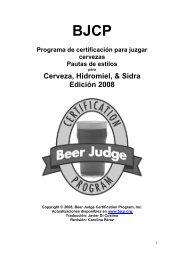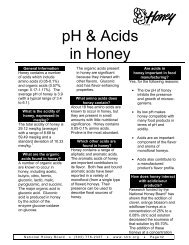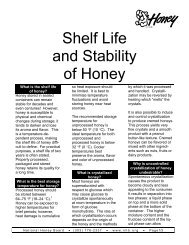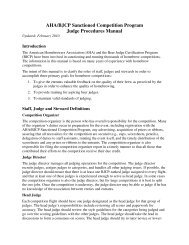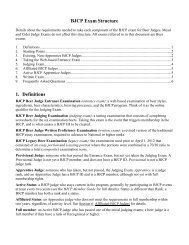Cap Management in Melomel - BJCP
Cap Management in Melomel - BJCP
Cap Management in Melomel - BJCP
You also want an ePaper? Increase the reach of your titles
YUMPU automatically turns print PDFs into web optimized ePapers that Google loves.
CO 2 :<br />
If the cap is not broken up or "punched down" the CO 2 buildup under<br />
the cap will deprive your yeast of oxygen. Oxygen is required by the<br />
yeast for optimal ethanol tolerance. This is why we aerate dur<strong>in</strong>g the<br />
first third of fermentation <strong>in</strong> order to get O2 <strong>in</strong>to the must for the<br />
yeast which enables the synthesis of sterols <strong>in</strong> order to strengthen the<br />
cell walls. One may th<strong>in</strong>k of O2 as a rudimentary yeast nutrient dur<strong>in</strong>g<br />
early fermentation for the benefit of the cell walls. Healthy cell walls<br />
are needed to:<br />
• Provide resistance to the rapidly ris<strong>in</strong>g level of alcohol<br />
• Regulate osmotic pressure across the cell wall<br />
• Effectively transport nitrogen <strong>in</strong>to the cell<br />
• Help regulate pH with<strong>in</strong> the cytoplasm<br />
• Ensure that the yeast cells are able to reproduce efficiently and<br />
proceed unstressed throughout the fermentation<br />
Aga<strong>in</strong>, if the yeast is not perform<strong>in</strong>g to it's spec based on improper cap<br />
management or nutrient poor must, the fermentation be become<br />
stuck, or just drag on forever.<br />
Dry<strong>in</strong>g:<br />
If the cap isn't pressed down <strong>in</strong>to the must frequently (this depends on<br />
how much fruit you use, along with the type of fruit, i.e. purees will<br />
take less punch<strong>in</strong>g down than crushed fresh, frozen or rehydrated<br />
dried fruit) to keep it moist the top will dry and spoilage organisms can<br />
set <strong>in</strong> which then compete with your yeast produc<strong>in</strong>g off flavors, or<br />
worse completely spoil<strong>in</strong>g your mead. Aga<strong>in</strong>, if the yeast is<br />
compromised <strong>in</strong>to a position of fight<strong>in</strong>g for dom<strong>in</strong>ance <strong>in</strong> the must,<br />
they will not be do<strong>in</strong>g their primary job of a fast, clean ferment.<br />
Early exposure to oxygen for both the yeast and the fruit dur<strong>in</strong>g<br />
primary is very important <strong>in</strong> the formation of the overall fruit flavor<br />
and character. S<strong>in</strong>k<strong>in</strong>g the fruit <strong>in</strong> a gra<strong>in</strong> bag is also practiced widely<br />
and yields very good results. Bear <strong>in</strong> m<strong>in</strong>d that for very large fruit<br />
additions (3-4 lbs of fruit/gallon of must) us<strong>in</strong>g a gra<strong>in</strong> bag may be<br />
impractical and the use of a plastic bucket provides easier<br />
management and access to the ferment<strong>in</strong>g must and fruit.






